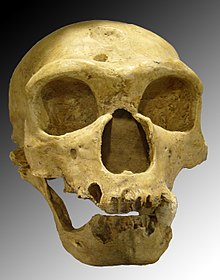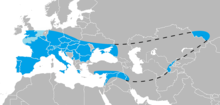Neanderthal man
| Neanderthal Temporal range: – 0.250–0.040 Ma |
|
|---|---|
 |
|
| The Neanderthal skull of La Chapelle-aux-Saints 1 | |
 |
|
| An approximate reconstruction of a Neanderthal skeleton at the American Museum of Natural History | |
| Scientific classification | |
| Kingdom: | Animalia |
| Phylum: | Chordata |
| Class: | Mammalia |
| Order: | Primates |
| Suborder: | Haplorhini |
| Family: | Hominidae |
| Genus: | Homo |
| Species: | H. neanderthalensis |
| Binomial name | |
|
Homo neanderthalensis King, 1864 |
|
 |
|
| Range of Homo neanderthalensis. Eastern and northern ranges may extend to include Okladnikov in Altai and Mamotnaia in Ural | |
| Synonyms | |
|
Homo mousteriensis |
|
Homo mousteriensis
Homo sapiens neanderthalensis
Palaeoanthropus neanderthalensis
Neanderthals, or more rarely Neandertals, (UK /niˈændərˌtɑːl/, us also /neɪ/-, -/ˈɑːndər/-, -/ˌtɔːl/, -/ˌθɔːl/; named for the Neandertal region in Germany) were a species or subspecies of archaic humans in the genus Homo that went extinct about 40,000 years ago. Neanderthals and modern humans share 99.7% of their DNA and are hence closely related. (By comparison, both modern humans and Neanderthals share 98.8% of their DNA with their closest non-human living relatives, the chimpanzees.) Neanderthals left bones and stone tools in Eurasia, from Western Europe to Central and Northern Asia. Due to accumulating genetic and fossil evidence suggesting Neanderthals evolved in Europe separately from modern humans in Africa for over 600,000 years, paleontologists generally classify them as a distinct species, Homo neanderthalensis. From the 1950s to the early 1980s, however, Neanderthals were widely considered a subspecies of Homo sapiens (H. s. neanderthalensis) and a minority of scholars still hold this view.
...
Wikipedia
